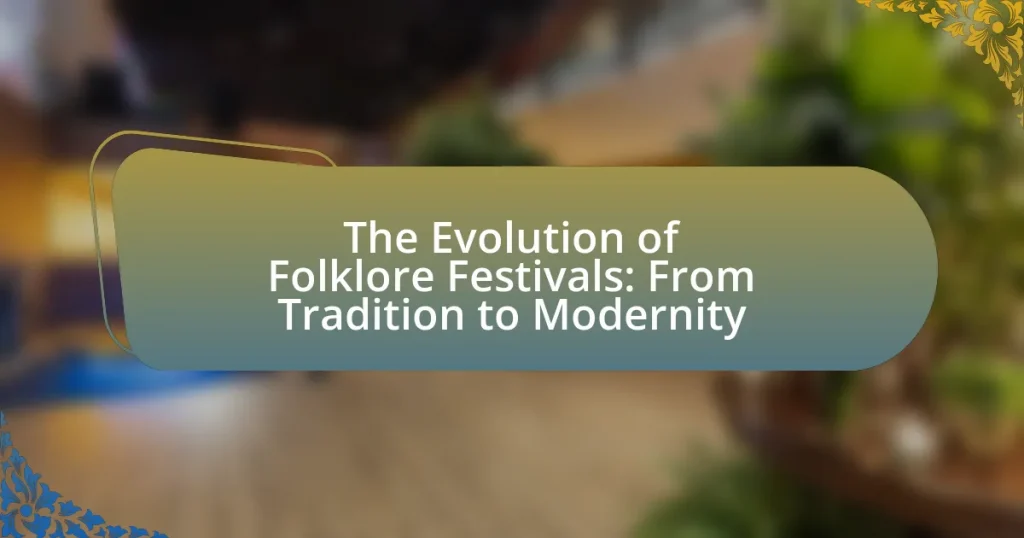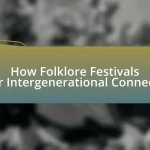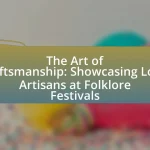Folklore festivals are cultural celebrations that highlight traditional music, dance, crafts, and storytelling, serving as vital means for preserving cultural identity and fostering community cohesion. Originating from ancient rituals and seasonal celebrations, these festivals have evolved significantly over time, adapting to contemporary values while maintaining their historical significance. The article explores the origins, cultural practices, and historical roles of folklore festivals, as well as their evolution in the modern era, including the impact of globalization and technology. It also addresses contemporary trends, challenges, and strategies for keeping these festivals relevant, emphasizing the importance of community engagement and diverse programming in enhancing the festival experience.
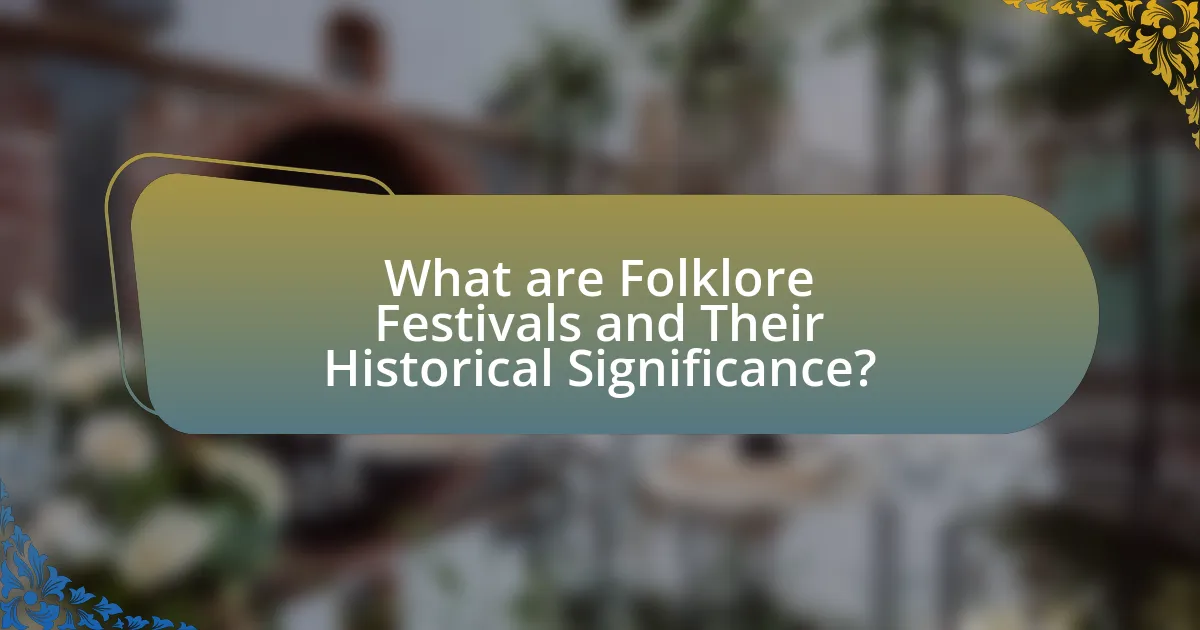
What are Folklore Festivals and Their Historical Significance?
Folklore festivals are cultural celebrations that showcase traditional music, dance, crafts, and storytelling, reflecting the heritage and customs of a community. Historically, these festivals have served as vital means for preserving cultural identity, fostering community cohesion, and passing down traditions through generations. For instance, the International Folklore Festival in Sofia, Bulgaria, which began in 1966, highlights the importance of folklore in maintaining national identity amidst globalization. Such events not only celebrate local customs but also promote cultural exchange, illustrating their significance in both historical and contemporary contexts.
How did folklore festivals originate?
Folklore festivals originated as communal celebrations that showcased traditional customs, stories, and practices of specific cultures. These festivals emerged from ancient rituals and seasonal celebrations, often linked to agricultural cycles, religious observances, or significant historical events. For example, many European folklore festivals can be traced back to harvest celebrations or pagan rituals that honored deities and nature. The preservation and promotion of cultural heritage through these festivals became increasingly important in the 19th century, as movements to document and celebrate local traditions gained momentum, leading to the establishment of organized folklore festivals that continue to thrive today.
What cultural practices influenced the early development of folklore festivals?
Cultural practices such as oral storytelling, communal rituals, and seasonal celebrations significantly influenced the early development of folklore festivals. Oral storytelling served as a primary means of preserving and transmitting cultural narratives, which became central to festival themes. Communal rituals, often tied to agricultural cycles or religious observances, fostered community bonding and participation, leading to the organization of collective festivities. Seasonal celebrations, marking events like harvests or solstices, provided structured opportunities for communities to gather, share traditions, and celebrate their cultural heritage. These practices laid the groundwork for the rich tapestry of folklore festivals that emerged, reflecting the values and identities of the communities involved.
How did folklore festivals serve communities in the past?
Folklore festivals served communities in the past by fostering social cohesion and preserving cultural heritage. These events provided a platform for community members to gather, share stories, and celebrate traditions, which reinforced communal bonds. Historical evidence shows that festivals often included rituals, music, and dance that reflected the unique identity of the community, helping to transmit cultural values and practices across generations. For instance, in many agrarian societies, harvest festivals not only marked the end of the growing season but also served as a communal celebration that strengthened relationships among villagers and ensured the continuity of agricultural traditions.
What role do folklore festivals play in preserving traditions?
Folklore festivals play a crucial role in preserving traditions by providing a platform for the transmission and celebration of cultural heritage. These festivals facilitate the sharing of traditional music, dance, crafts, and storytelling, which are essential components of a community’s identity. For instance, events like the National Folk Festival in the United States showcase diverse cultural expressions, allowing participants to engage with and learn about various traditions. This active participation helps to maintain cultural practices that might otherwise fade away, reinforcing community bonds and fostering intergenerational knowledge transfer.
How do folklore festivals contribute to cultural identity?
Folklore festivals contribute to cultural identity by serving as platforms for the expression and preservation of traditional customs, stories, and practices. These festivals allow communities to showcase their unique heritage through music, dance, art, and food, reinforcing a sense of belonging and continuity among participants. For instance, the annual Albuquerque International Balloon Fiesta in New Mexico not only celebrates ballooning but also highlights Native American culture, fostering pride and awareness of local traditions. By engaging in these communal activities, individuals strengthen their ties to their cultural roots, ensuring that their identity is maintained and passed down through generations.
What methods are used to pass down folklore through festivals?
Folklore is passed down through festivals primarily via storytelling, performances, and rituals. Storytelling serves as a vehicle for sharing traditional tales and legends, often performed by community members during festival gatherings. Performances, including music, dance, and theater, bring folklore to life, allowing participants to engage with cultural narratives in an immersive way. Rituals, which may include ceremonies or symbolic acts, reinforce community bonds and cultural identity, ensuring that the values and beliefs embedded in folklore are transmitted to future generations. Historical evidence shows that many festivals, such as the Carnival in Brazil or Diwali in India, incorporate these methods, highlighting their role in preserving and promoting cultural heritage.
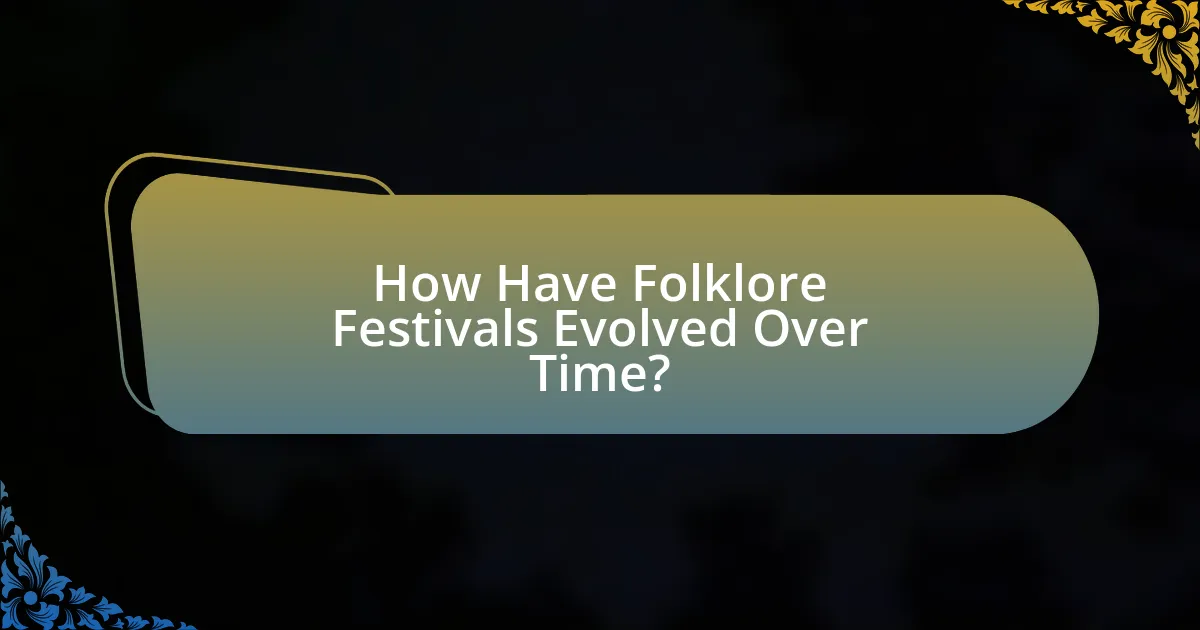
How Have Folklore Festivals Evolved Over Time?
Folklore festivals have evolved from local, community-based celebrations of cultural traditions to large-scale, commercially-driven events that attract diverse audiences. Initially, these festivals served as a means to preserve and transmit cultural heritage, often featuring traditional music, dance, and storytelling specific to a region. Over time, particularly from the mid-20th century onward, globalization and technological advancements have influenced their format and reach, leading to the incorporation of contemporary elements and the blending of various cultural practices. For example, the rise of social media has enabled festivals to promote themselves internationally, drawing in tourists and creating a fusion of traditional and modern artistic expressions. This evolution reflects broader societal changes, including increased mobility and cultural exchange, which have transformed folklore festivals into platforms for both cultural preservation and innovation.
What changes have occurred in folklore festivals in the modern era?
Folklore festivals in the modern era have evolved significantly, reflecting changes in cultural expression and societal values. These festivals now often incorporate contemporary elements such as digital technology, social media promotion, and diverse artistic performances, which attract broader audiences. For instance, many festivals have shifted from purely traditional displays to include modern interpretations of folklore, blending genres like pop music with traditional dance. Additionally, there is a growing emphasis on inclusivity and representation, with festivals increasingly showcasing a variety of cultural backgrounds and narratives. This transformation is evidenced by the rise of festivals that celebrate multiculturalism, such as the Smithsonian Folklife Festival, which highlights diverse cultural heritages while adapting to modern sensibilities.
How has globalization impacted folklore festivals?
Globalization has significantly impacted folklore festivals by facilitating the exchange of cultural practices and increasing their visibility on a global scale. This phenomenon has led to the incorporation of diverse cultural elements into local festivals, enriching the traditional experiences while also attracting international audiences. For instance, festivals like the Edinburgh Festival Fringe have become platforms for showcasing a variety of global traditions, thereby promoting cultural diversity. Additionally, the rise of digital media has enabled folklore festivals to reach wider audiences, allowing for the sharing of performances and traditions beyond geographical boundaries. This interconnectedness can sometimes lead to the commercialization of folklore, where traditional practices are adapted to appeal to global tastes, potentially diluting their original meanings.
What technological advancements have influenced the presentation of folklore festivals?
Technological advancements such as digital media, social media platforms, and live streaming have significantly influenced the presentation of folklore festivals. Digital media allows for high-quality audio and visual recordings, enhancing the overall experience for attendees and enabling wider distribution of festival content. Social media platforms facilitate real-time engagement and promotion, allowing festivals to reach larger audiences and attract participants globally. Live streaming technology enables remote audiences to experience the festival as it happens, increasing accessibility and participation. These advancements have transformed traditional folklore festivals into more interactive and globally recognized events, as evidenced by the rise in online viewership and social media engagement metrics during major festivals.
Why do some traditions fade while others persist in folklore festivals?
Some traditions fade while others persist in folklore festivals due to factors such as cultural relevance, community engagement, and adaptability to contemporary values. Traditions that resonate with current societal norms and values tend to thrive, as they attract participation and interest from the community. For instance, festivals that incorporate modern themes or address contemporary issues often see increased attendance and support. Conversely, traditions that become disconnected from the community’s identity or fail to evolve with changing times may lose significance and gradually fade away. Historical examples include the decline of certain agricultural festivals as urbanization increased, while celebrations that embrace multiculturalism and inclusivity have gained popularity, demonstrating their ability to adapt and remain relevant.
What factors contribute to the adaptation of folklore in contemporary festivals?
The adaptation of folklore in contemporary festivals is primarily influenced by globalization, technological advancements, and cultural exchange. Globalization facilitates the blending of diverse cultural elements, allowing traditional folklore to be reinterpreted and integrated into modern contexts. Technological advancements, such as social media and digital platforms, enable wider dissemination and participation in folklore, making it accessible to a global audience. Cultural exchange, driven by migration and intercultural interactions, encourages the incorporation of new ideas and practices into traditional folklore, resulting in dynamic and evolving festival expressions. These factors collectively ensure that folklore remains relevant and engaging in contemporary settings.
How do audience expectations shape the evolution of folklore festivals?
Audience expectations significantly influence the evolution of folklore festivals by driving organizers to adapt performances and programming to meet contemporary interests. As audiences increasingly seek interactive and immersive experiences, festivals have incorporated modern elements such as technology, diverse cultural representations, and participatory activities. For instance, the integration of social media platforms allows for real-time audience engagement, shaping the festival’s content and marketing strategies. This shift is evident in festivals like the Smithsonian Folklife Festival, which has evolved to include contemporary artists and interactive workshops, reflecting audience desires for relevance and connection to current cultural narratives.
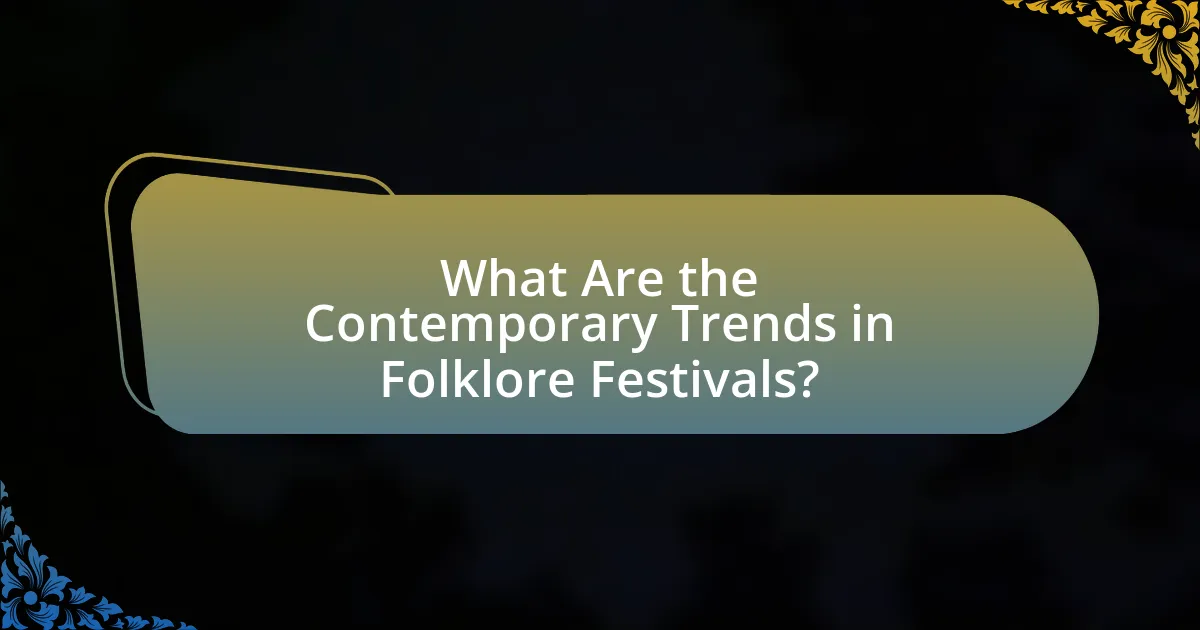
What Are the Contemporary Trends in Folklore Festivals?
Contemporary trends in folklore festivals include a focus on cultural diversity, sustainability, and digital engagement. Many festivals now showcase a wide range of cultural expressions, reflecting the globalization of traditions and the inclusion of marginalized voices. For instance, festivals often feature performances from various ethnic groups, promoting intercultural dialogue and understanding. Additionally, there is an increasing emphasis on sustainability, with many events adopting eco-friendly practices, such as waste reduction and local sourcing of materials. Digital engagement has also become prominent, as festivals utilize social media and live streaming to reach broader audiences, enhancing participation and visibility. These trends demonstrate the evolving nature of folklore festivals, adapting to modern societal values while preserving cultural heritage.
How are modern folklore festivals incorporating diverse cultural elements?
Modern folklore festivals are incorporating diverse cultural elements by featuring a wide range of performances, workshops, and exhibits that represent various ethnic traditions and contemporary interpretations. These festivals often include music, dance, and storytelling from different cultures, allowing attendees to experience a blend of global traditions. For instance, many festivals now showcase multicultural food stalls, art installations, and interactive sessions that highlight the heritage of immigrant communities, reflecting the demographic changes in society. This integration not only enriches the festival experience but also fosters cultural exchange and understanding among participants, as evidenced by events like the Smithsonian Folklife Festival, which emphasizes cultural diversity through its programming.
What role do multicultural influences play in today’s folklore festivals?
Multicultural influences play a significant role in today’s folklore festivals by enriching the diversity of cultural expressions and fostering cross-cultural understanding. These festivals often showcase a variety of traditions, music, dance, and storytelling from different ethnic groups, reflecting the globalized nature of contemporary society. For instance, events like the Smithsonian Folklife Festival in Washington, D.C., highlight the contributions of various cultures, promoting inclusivity and appreciation for cultural heritage. This blending of traditions not only preserves folklore but also adapts it to modern contexts, allowing for innovation while maintaining cultural significance.
How do contemporary folklore festivals address social issues?
Contemporary folklore festivals address social issues by serving as platforms for dialogue, cultural expression, and community engagement. These festivals often highlight themes such as social justice, environmental sustainability, and cultural diversity through performances, workshops, and discussions. For instance, many festivals incorporate local artists and marginalized voices, fostering inclusivity and raising awareness about social challenges faced by these communities. Research indicates that festivals like the Smithsonian Folklife Festival actively engage with contemporary issues, showcasing projects that address climate change and cultural preservation, thereby reinforcing their role as catalysts for social change.
What are the challenges faced by folklore festivals today?
Folklore festivals today face several significant challenges, including declining attendance, funding shortages, and the struggle to maintain authenticity in a rapidly changing cultural landscape. Declining attendance can be attributed to competition from other entertainment options and changing audience demographics, which have shifted towards digital experiences. Funding shortages often arise from reduced government support and sponsorship, making it difficult for organizers to cover costs and promote events effectively. Additionally, the challenge of maintaining authenticity is critical, as festivals must balance traditional practices with modern expectations and trends, risking the dilution of cultural heritage. These challenges collectively threaten the sustainability and relevance of folklore festivals in contemporary society.
How do economic factors affect the sustainability of folklore festivals?
Economic factors significantly influence the sustainability of folklore festivals by determining funding, attendance, and local economic impact. Festivals often rely on sponsorships, ticket sales, and local business support; when economic conditions are poor, these revenue streams can diminish, leading to reduced festival budgets and potential cancellations. For instance, a study by the National Endowment for the Arts found that festivals with strong local business partnerships are more likely to thrive, as they create a symbiotic relationship that boosts both the festival and the local economy. Additionally, economic downturns can lead to decreased attendance, as potential visitors may prioritize essential spending over leisure activities, further straining the financial viability of these cultural events.
What strategies can be employed to keep folklore festivals relevant?
To keep folklore festivals relevant, organizers can integrate modern technology and social media to enhance engagement and reach wider audiences. By utilizing platforms like Instagram and Facebook, festivals can showcase live performances, share stories, and interact with attendees in real-time, thus attracting younger generations who are more digitally connected. Additionally, incorporating contemporary themes and issues into traditional narratives can resonate with current societal values, making the festivals more relatable. For instance, festivals that address topics like sustainability or cultural diversity can draw in participants who are passionate about these issues. Research indicates that festivals that adapt to changing cultural landscapes see increased attendance and community involvement, demonstrating the effectiveness of these strategies.
What best practices can enhance the experience of folklore festivals?
To enhance the experience of folklore festivals, organizers should prioritize community involvement, diverse programming, and effective marketing strategies. Community involvement fosters a sense of ownership and pride among local participants, which can lead to increased attendance and engagement. For instance, festivals that incorporate local artists and performers often see higher participation rates, as evidenced by the success of the National Folk Festival in the United States, which emphasizes local talent. Diverse programming, including workshops, storytelling sessions, and interactive activities, caters to various audience interests and encourages deeper cultural appreciation. Effective marketing strategies, such as utilizing social media and partnerships with local businesses, can significantly boost visibility and attract a wider audience. Research indicates that festivals with strong marketing efforts can increase attendance by up to 30%.
How can organizers effectively engage the community in folklore festivals?
Organizers can effectively engage the community in folklore festivals by incorporating local traditions and encouraging community participation in planning and execution. This approach fosters a sense of ownership and pride among community members, which is essential for successful engagement. For instance, involving local artisans and performers not only showcases regional talent but also strengthens cultural ties. Research indicates that festivals that actively involve the community see increased attendance and satisfaction, as evidenced by a study conducted by the National Endowment for the Arts, which found that community-driven events enhance social cohesion and cultural appreciation.
What innovative approaches can be used to attract younger audiences to folklore festivals?
To attract younger audiences to folklore festivals, integrating technology such as augmented reality (AR) and social media engagement is essential. AR can enhance the festival experience by providing interactive storytelling elements that connect traditional folklore with modern technology, making it more relatable to younger generations. For instance, festivals can create AR apps that allow attendees to visualize folklore characters and stories in real-time, thereby deepening their engagement. Additionally, leveraging social media platforms for live streaming performances and behind-the-scenes content can create a buzz and foster a sense of community among younger audiences. According to a study by the Pew Research Center, 95% of teenagers have access to a smartphone, indicating that digital engagement strategies can effectively reach this demographic.










